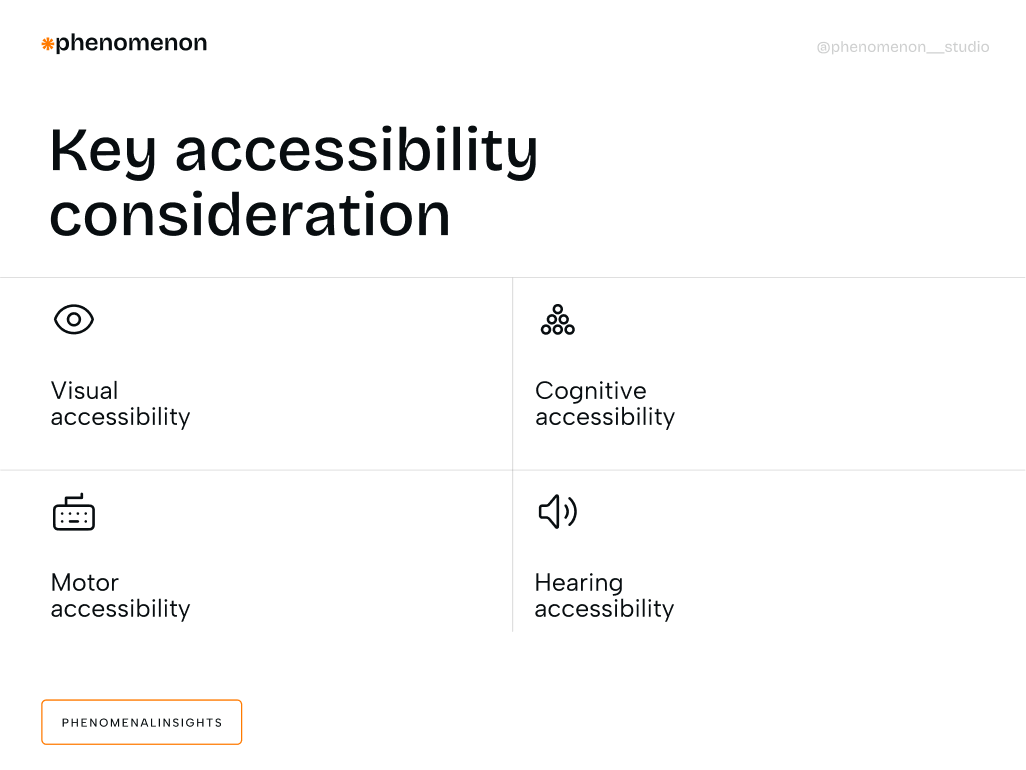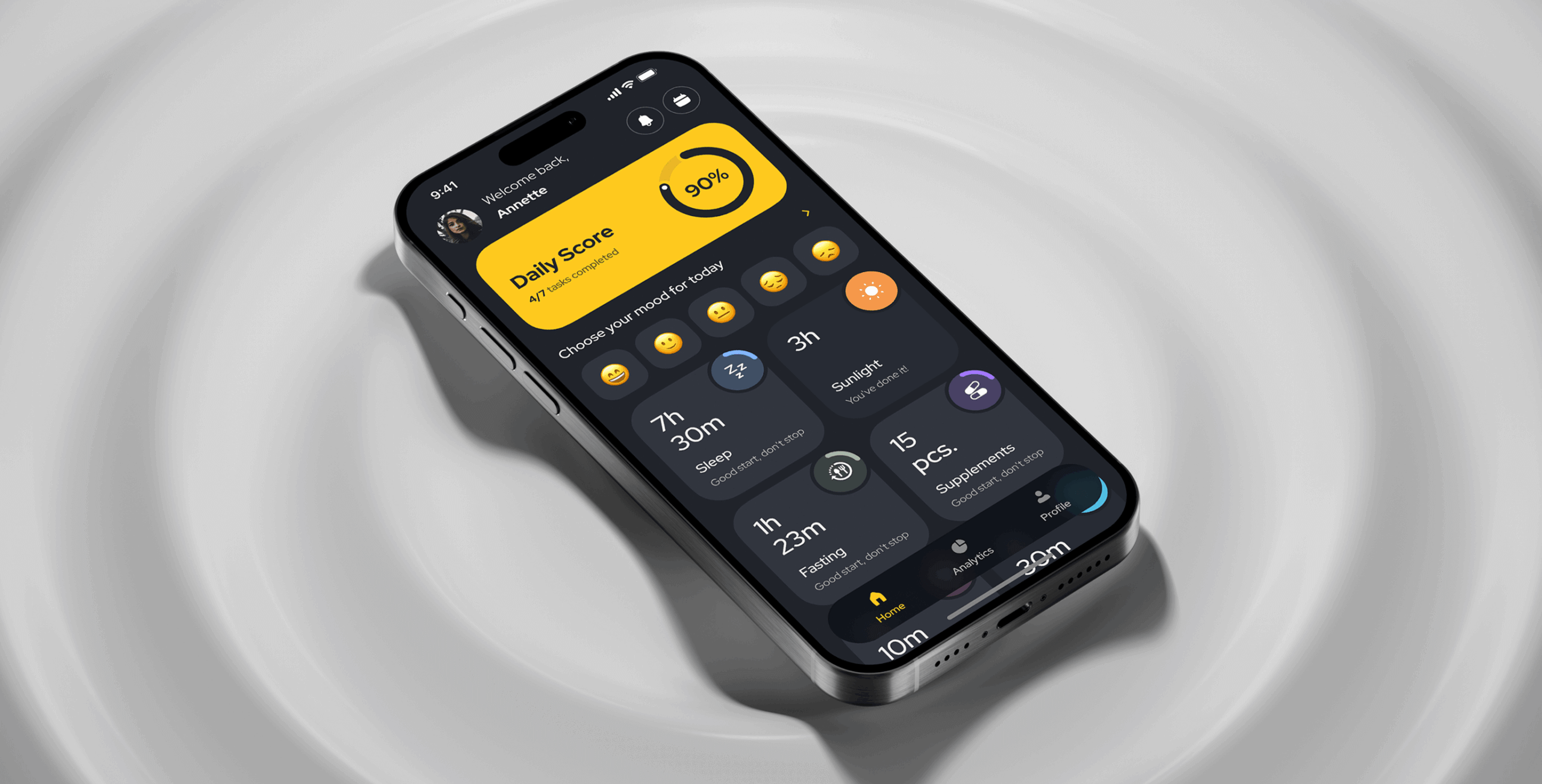Discover how accessibility in HealthTech drives product performance, expands market reach, and improves outcomes for all users beyond compliance.
When healthcare technology fails to work for everyone, it’s not just an ethical problem. It’s a performance issue that affects your entire product’s success. While many HealthTech companies view accessibility as a compliance checkbox, forward-thinking healthcare organizations recognize it as a catalyst for innovation and improved outcomes.
Accessibility in healthcare technology means designing digital health solutions that work effectively for people with disabilities, chronic conditions, and varying levels of digital literacy, while also addressing the specific needs of diverse users. This includes everything from screen reader compatibility to clear visual design and simplified navigation patterns.
The stakes are particularly high in healthcare. When a patient management system excludes users with visual impairments, or when a telehealth platform doesn’t support hearing aids properly, the consequences extend far beyond user frustration. These barriers can directly impact health outcomes and limit your product’s market reach. Accessible HealthTech also plays a crucial role in streamlining operations for healthcare organizations, enabling more efficient workflows and better patient engagement.
Introduction to HealthTech
HealthTech, or digital health, represents the dynamic intersection of healthcare and technology, transforming how care is delivered and experienced. By leveraging innovative solutions such as electronic health records (EHRs), telemedicine platforms, mobile health apps, and artificial intelligence, healthcare organizations are redefining patient care and driving better health outcomes. The adoption of HealthTech solutions enables healthcare providers to enhance patient care, streamline operations, and improve patient access to essential services. As the healthcare industry continues to evolve, digital health technologies are playing a pivotal role in delivering better patient outcomes, reducing costs, and ensuring that care is more accessible and effective for everyone. Ultimately, HealthTech is not just about technology—it’s about using the right solutions to improve health, empower patients, and advance the future of healthcare.
The Performance Case for Accessible HealthTech for Healthcare Organizations
Building accessible HealthTech solutions delivers measurable performance benefits that extend to every user, not just those with disabilities. By prioritizing accessibility, organizations can better align their software development processes with their business goals, ensuring that strategic objectives are met through inclusive and effective technology.
Expanded Market Reach
Over 61 million adults in the United States live with a disability, representing a significant portion of potential healthcare consumers. When your HealthTech product excludes this population, you’re limiting your addressable market by design.
Accessible design also benefits the growing population of older adults who increasingly rely on digital health tools. Age-related changes in vision, hearing, and motor skills mean that accessibility features become essential for this demographic.
Additionally, accessible HealthTech solutions can help reach underserved areas by expanding healthcare access through digital platforms and innovative services, ensuring that populations with limited healthcare coverage are not left behind.
Improved Usability for All Users
Accessibility improvements typically enhance the experience for everyone using your product. Clear contrast ratios help users in bright environments. Simple navigation benefits people using devices in stressful medical situations. Voice controls serve users whose hands are occupied with medical equipment.
These universal benefits mean that accessibility investments improve your core product metrics across the board, while also enhancing the patient experience. Improved usability leads to better patient experiences throughout the healthcare journey, supporting more personalized, seamless, and patient-centered care.
Reduced Development Costs
Integrating accessibility from the start costs significantly less than retrofitting existing products. When you build accessibility into your design system and development process, you avoid the expensive redesign cycles that come with post-launch accessibility audits.
Teams that prioritize accessibility also tend to write cleaner, more maintainable code. The structured approach required for accessible development often results in better overall code quality and fewer technical debt issues.
Key Accessibility Considerations for HealthTech

Healthcare technology presents unique accessibility challenges that require targeted solutions. By addressing accessibility, HealthTech environments can also achieve workflow optimization, as accessible systems streamline clinical, administrative, and operational processes for both users and organizations.
Visual Accessibility
Many HealthTech interfaces rely heavily on color coding, charts, and visual data representation. These elements need alternative formats to serve users with visual impairments.
Implement proper alt text for medical images and charts. Ensure sufficient color contrast ratios, particularly for critical information like alerts or warnings. Design interfaces that work effectively with screen readers, including proper heading structures and form labels.
Cognitive Accessibility
Healthcare information can be complex and overwhelming. Cognitive accessibility focuses on making this information digestible for users with cognitive disabilities, learning differences, or anyone experiencing medical stress.
Use plain language for medical instructions. Break complex processes into clear, sequential steps. Provide multiple ways to access the same information, such as both text and audio instructions for medication reminders.
Motor Accessibility
Users may have limited mobility due to medical conditions, temporary injuries, or the use of assistive devices. Your HealthTech solution needs to accommodate various input methods and interaction patterns, including the importance of accessible mobile apps for users with limited mobility.
Design larger touch targets for mobile interfaces. Ensure all functionality is available through keyboard navigation. Consider voice control options for hands-free interaction during medical procedures or while using medical equipment.
Hearing Accessibility
Audio elements in HealthTech applications need alternatives for users with hearing impairments. This includes everything from notification sounds to video consultations.
Provide captions for all video content. Use visual indicators alongside audio alerts. Ensure compatibility with hearing aids and assistive listening devices for telehealth platforms.
Patient Engagement and Accessibility
Patient engagement and accessibility are at the heart of successful HealthTech solutions. Engaged patients are more likely to participate actively in their care, follow treatment plans, and achieve better health outcomes. Custom healthcare software development empowers healthcare providers to offer tailored experiences, such as real-time access to patient records, secure messaging, and personalized health and fitness tracking. These features not only improve patient engagement but also make healthcare services more accessible, especially through remote patient monitoring and mobile health apps. By integrating HealthTech solutions that prioritize accessibility, healthcare organizations can ensure that all patients—regardless of ability or location—can easily connect with providers, access critical information, and manage their treatment plans. This approach leads to more effective care management, improved patient outcomes, and a more inclusive healthcare ecosystem.
Implementation Strategies That Work
Successfully integrating accessibility into your HealthTech development requires systematic approaches and clear processes. Ongoing support is essential to maintain accessibility standards after initial implementation, ensuring that your solutions remain compliant and effective over time.
Start with User Research
Include people with disabilities in your user research from the beginning. Their insights will reveal accessibility barriers you might not anticipate and help prioritize which features will have the greatest impact.
Conduct usability testing with assistive technologies. Test your interfaces with screen readers, voice control software, and other accessibility tools that your users actually employ. This process generates actionable insights for improving accessibility.
Leveraging data driven insights from user research can further guide accessibility enhancements.
Build Accessibility into Custom Healthcare Software Development Design Systems
Create design components with accessibility built in rather than added on. This approach ensures consistency across your product and makes it easier for developers to implement accessible features correctly. Custom software allows you to embed accessibility from the ground up, unlike off the shelf solutions, which often lack the flexibility to address specific accessibility needs.
Document accessibility requirements alongside visual specifications. Include keyboard navigation patterns, screen reader instructions, and alternative text guidelines in your design documentation.
Establish Testing Protocols
Implement both automated and manual accessibility testing throughout your development cycle. Automated tools can catch many common issues, but manual testing with real assistive technologies provides deeper insights.
Create accessibility checklists specific to healthcare contexts. These should cover medical data presentation, emergency alert systems, and compliance with healthcare-specific accessibility standards. Third-party vendors can play a crucial role by conducting accessibility audits to verify that your solutions meet regulatory requirements.
Train Your Team
partner like Phenomenon Studio comes in.
We don’t just talk about accessibility – we integrate it at every stage: from design sprints and code reviews to product launches. By training your team and embedding accessibility into QA processes, we ensure that inclusive design becomes a natural part of your product’s DNA.
Take Zest as an example – a bold healthtech app empowering users to take control of their longevity.
- We launched an MVP in just 1 month, helping the client start generating revenue ahead of schedule.
- Our focus on essential features cut development costs by 25% while keeping the product scalable.
- We translated complex scientific insights into accessible, easy-to-use tools, making health optimization approachable for every user.
If you want your next product to be just as user-friendly, inclusive, and impactful, let’s talk. With Phenomenon Studio, accessibility becomes a competitive advantage – not an afterthought.

Regulatory Compliance and Accessibility
In the healthcare industry, regulatory compliance is essential for protecting patient data and ensuring the safe delivery of healthcare services. Healthcare organizations must adhere to strict regulations, such as HIPAA, to safeguard sensitive patient data and maintain trust. At the same time, accessibility is a critical requirement—patients with disabilities must be able to access healthcare information and services without barriers. Custom healthcare software development enables healthcare providers to meet these dual challenges by creating secure, user-friendly, and accessible HealthTech solutions. By embedding accessibility features and robust security protocols into healthcare software, organizations can protect patient data, improve patient safety, and deliver better patient outcomes. This commitment to compliance and accessibility not only reduces the risk of medical errors but also ensures that healthcare services are equitable and effective for all patients.
Cybersecurity and Accessible HealthTech
As HealthTech solutions become more advanced, cybersecurity remains a top priority for healthcare organizations. Protecting patient data from cyber threats is essential to maintaining trust and ensuring the integrity of healthcare services. Accessible HealthTech solutions go beyond security—they provide patients and providers with secure, intuitive access to medical information, supporting better patient care and outcomes. Through custom healthcare software development, organizations can leverage the latest technologies, including artificial intelligence, machine learning, and cloud computing, to build innovative solutions that are both secure and accessible. These technologies enable healthcare providers to enhance patient care, streamline operations, and reduce costs, all while ensuring that sensitive data is protected. By prioritizing cybersecurity and accessibility together, healthcare organizations can deliver HealthTech solutions that meet the needs of today’s patients and providers, driving better health outcomes across the healthcare ecosystem.
Measuring Accessibility Impact to Improve Health Outcomes
Track metrics that demonstrate how accessibility improvements affect your product’s overall performance and user satisfaction. Leverage health data and medical big data to measure the impact of accessibility improvements, using analytics to gain insights into how changes benefit diverse user groups.
Monitor user engagement across different ability levels. Look for patterns in feature adoption, task completion rates, and user retention that might indicate accessibility barriers.
Collect feedback specifically about accessibility features. Users with disabilities often provide valuable insights about which accommodations work well and which need improvement.
Track compliance metrics alongside performance indicators. This helps demonstrate the business value of accessibility investments to stakeholders who focus primarily on financial outcomes.
Building Better HealthTech Through Inclusive Design
Accessibility in HealthTech represents an opportunity to create products that genuinely serve their intended purpose: improving health outcomes for everyone. Digital transformation is ushering in a new era in the healthcare field, where technology-driven solutions are reshaping patient care and wellness.
The most successful HealthTech companies recognize that accessibility and performance are interconnected goals, not competing priorities. These companies are transforming the healthcare system through SaaS platforms and integration with hospital systems, enabling more efficient, connected, and patient-centered care. By implementing systematic accessibility practices, you position your product for broader market success while fulfilling healthcare technology’s fundamental promise of improving lives.
Start by auditing your current product for accessibility barriers. Inclusive design supports improving patient outcomes, improve health outcomes, and improve patient care, especially in areas like cancer treatment, wellness, and medicine. Identify the highest-impact improvements you can make, then integrate accessibility considerations into your ongoing development process. The investment in accessible design pays dividends in user satisfaction, market reach, and product performance that benefits everyone who relies on your healthcare technology. It is also essential to serve clients, businesses, healthcare startups, and support health insurance integration to ensure your solutions meet the needs of the entire healthcare ecosystem.













